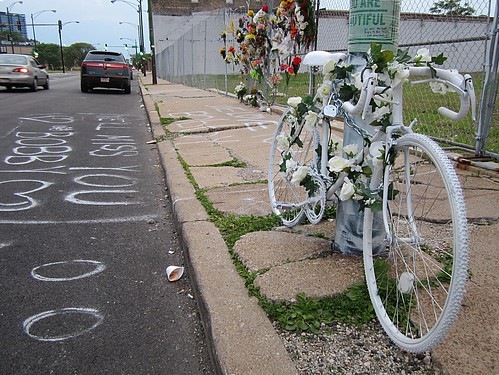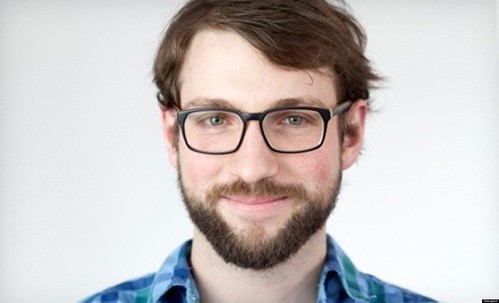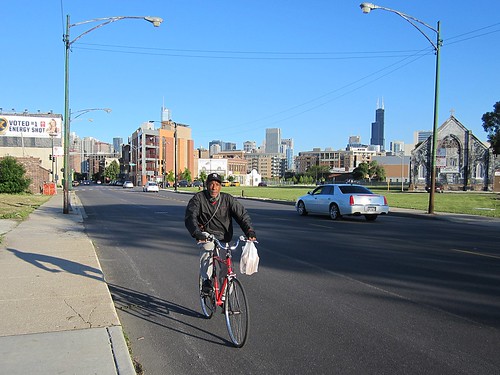Last Thursday, about a week after the May 29th death of cyclist Robert “Bobby” Cann, killed by an allegedly drunk, speeding driver at Clybourn and Larrabee, the Chicago Department of Transportation announced plans to stripe buffered bike lanes on the entire 3.5-mile length of Clybourn, from Division to Belmont. Construction should start either this week or the following week, according to CDOT spokesperson Pete Scales.
According to police, Ryne San Hamel, 28, had a blood-alcohol content of .127 and was driving his Mercedes sedan at 50 mph when he struck Cann, 25, on the 1300 block of North Clybourn. San Hamel has been charged with reckless homicide, aggravated DUI, misdemeanor DUI, reckless driving, and failure to stay in the lane. Bail was set at $100,000; the driver has posted $10,000 and was released from police custody.
Several memorials and tributes have been held in honor of Cann, a Groupon employee widely described as a safe cycling advocate. Cann's coworkers recently started a memorial Groupon that has raised over $40,000 for the Active Transportation Alliance's Neighborhood Bikeways Campaign, which advocates for protected bike lanes. The Groupon was scheduled to end yesterday but has been extended. Bob Kastigar, a longtime Chicago bike activist and Critical Mass rider, launched a petition drive asking that the county’s top prosecutor, Anita Alvarez, send the case to court instead of making a plea bargain; Kastigar mailed Alvarez a 432-page printout with 5,274 signatures, which arrived yesterday.
I got the news about the bike lanes from a RedEye article that described the lanes as “protected,” which highlights the confusion caused by CDOT reclassifying buffered lanes as “buffer-protected” last year. Rahm Emanuel’s 2011 transition plan called for building 100 miles of protected lanes in his first term, defining protected lanes as sitting "between the sidewalk and a row of parked cars that shield cyclists from street traffic." Last year CDOT changed that definition so that "buffer-protected" lanes, could be counted towards the hundred-mile protected lane goal; parking-protected lanes were renamed "barrier-protected." For the rest of this article I'll use the standard, nationally accepted definitions of protected and buffered lanes.
In February, Steven Vance discovered that the Illinois Department of Transportation has been prohibiting the installation of protected lanes on state jurisdiction roads in Chicago at least until CDOT collects three years of “safety data” on existing Chicago protected lanes. That means the earliest than ban would be lifted would be July 2014, three years after Chicago's first protected lanes opened on Kinzie. IDOT has not blocked installation of buffered lanes.
Because of this ban, installing 100 miles of protected lanes by 2015 became less likely, so it’s understandable that CDOT adjusted its 100-mile goal to include buffered lanes, but it was a mistake for the agency to change the definition of "protected" lanes to include facilities that are merely paint on the road. While real protected lanes provide a physical barrier to prevent reckless drivers from crashing into cyclists, buffered lanes don't, and the two should not be confused.
The Cann tragedy makes this painfully clear. The city's Streets for Cycling Plan 2020 classifies Clybourn as a “Crosstown Bike Route,” a bike-priority street connecting neighborhoods. Clybourn is generally about 52-feet-wide, which would be enough room for two seven-foot-wide parking lanes, two five-foot bike lanes with a three-foot buffer, and two 11-foot travel lanes. Alternatively, there could be eight-foot parking lanes and ten-foot travel lanes. If IDOT hadn't been blocking the protected lanes, its likely CDOT would have installed them on the street instead of buffered lanes, possibly before the crash occured.
The circumstances of Cann's death are still unclear. He may have been struck in the intersection, in which case protected bike lane wouldn't have shielded him from San Hamel’s car. However, if the Clybourn parking lanes had been relocated to the left of protected lanes, this would have physically narrowed the travel lanes. That might have caused San Hamel to driver slower, which could have mitigated the crash. While it's impossible to say whether protected lanes would have saved Cann, it’s certain that they would have improved safety on Clybourn for other cyclists, more so than the upcoming buffered lanes will.
In the wake of Cann's death, IDOT tweeted support for CDOT’s plan for buffered lanes. As Steven wrote earlier, this is hypocritical, since the department blocked the protected lanes that might have made a difference in the crash, and IDOT has not changed its policies towards protected and buffered lanes at all in response to the case. The department is still blocking the protected lanes that could help prevent further loss of life.
Therefore, I have mixed feelings about the upcoming buffered lanes on Clybourn. CDOT is making the best of a bad situation by striping the lanes, which will be an improvement over the status quo. However, if IDOT actually cares about improving safety, the department needs to lift the ban on protected bike lanes immediately. That would make a real difference for keeping Chicago cyclists safe, and that would be a fitting legacy for Bobby Cann.
San Hamel is scheduled to appear at the Cook County courthouse at 26th and California on July 17 at 9 a.m. 18th District police officers are seeking volunteer court advocates, concerned citizens who appear in court to show their support for the victim. You can contact the 18th District CAPS officers at 312-742-5778 for more info. More details are available on The Chainlink from Active Trans’ Jason Jenkins.







